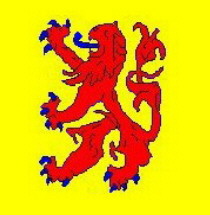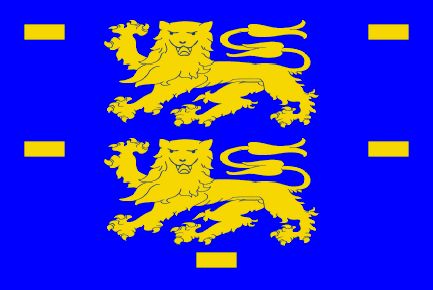[Home] (In Dutch only)The medieval castles of West-Frisia and Alkmaar
- English language pages-
Eenigenburg Castle.
(Update: 2016-05-05)
Contents of this page:
[Back to contents][Home]
Currently Eenigenburg is the name of a small village near the small town of Warmenhuizen. In the same region, near the village of Krabbendam we find the ruins of the foundations of Nuwendoorn Castle, situated between the villages of Krabbendam and Eenigenburg. Even today it can be seen the village of Eenigenburg was built on several artificial mounds. It is Nuwendoorn Castle's location; near the village, which caused all kinds of historical contradictions. Which makes it hard to prove that a castle named Eenigenburg Castle really existed.
Etymology
1. 'Burcht' or 'burg': Dutch word for a fortified place (castle, fortified house, fortified town, citadel). Also in Medieval Dutch: borch, burch. However the word 'burg' can also mean 'berg' or elevation, a artificial mound.
2. A plausible explanation is that the ancient names Eimhborch, Einchborch, Enichborch have some roots in old-Norse or Fries. Ee or ei means water and nigen (ningen, ninghen) means 'nearby'. So, 'the castle (or mound) near the water' (in these times the village was situated at a large sea bay which was called 'Zijpe').
In history the name has been mentioned several times as Einihborch (1289), Enigheburch (1318) (both: lit. 35). Also Eningenburch (de Beka, lit. 19), Enichborch (1289, lit. 19).
A minor twin castle?
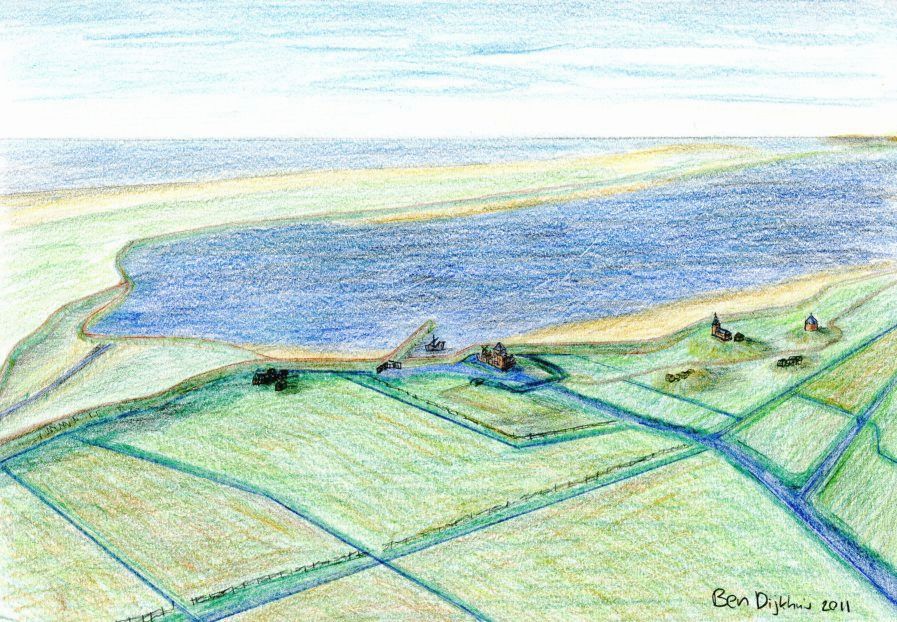 | A fantasy scene near the coast of the Zijpe in the 13th century. In the middle the Nuwendoorn Castle. On the right some building objects of Eenigenburg.
(Drawing: Ben Dijkhuis) |
View the scene of the drawing above. It suggests the existence of a second minor twin castle beside Nuwendoorn Castle (the latter is in the middle). The minor castle has been imaged like a round tower at the very right side situated at the top of the outside one of the two mounds. Would it be possible that this tiny fortress was Eenigenburg Castle?
This situation could be comparable to the two castles Florens V, the Count of Holland, built near Oudorp/Alkmaar: Nieuwburg Castle and (smaller one) Middelburg Castle.
Historians and chronicle writers
Melis Stoke, the Count's history writer mentioned in his "Rijmkroniek" ("Rhyme Chronicle") the five castles Florens V founded to consolidate his conquest of the Westfrisians: Wijdenes Castle, Medemblik Castle, Nieuwburg Castle, Middelburg Castle and Nuwendoorn Castle. However, Melis Stoke did not refer to a castle named Eenigenburg Castle! But the name of Eenigenburg was well known at the end of the 13th century, mentioned in 1289 as Enichborch (lit. 19) as one of the locations where a delegation from the bishop of Utrecht talked about the negotiation of peace with Florens V.
Chronicle writers of the 14th century described the foundation of four castles by Florens V. Johannis de Beka and "The Clerc uuten laghen landen bi der see" described Medemblik Castle, Middelburg Castle, Nieuwburg Castle and Eenigenburg Castle ("Eningenburch", "Enigeborch").
Resuming, we encounter some facts and contradictions:
- The name of Enigenburg points to a fortified place.
- The name Enichborch was already known at the end of the 13th century, during the period Florens V ruled.
- If a fortification with this name existed it cannot have been built by Florens V, because Melis Stoke did not mention a castle with such a name.
- Chronicle writers of the 14th century mentioned a castle named Eenigenburg Castle instead of Nuwendoorn Castle!
It is enigmatic how the latter contradiction appeared. After Nuwendoorn Castle had been heavily damaged in 1296 it was rebuilt again. The chronicle writers were able to check their work. Apparently they did not!
- The same chronicle writers ignored the foundation of the Castle of Wijdenes.
The chronicle of Johannes van Leiden (1692), mentioned five castles Florens built: in Wijdenes, in Medemblik, Nieuwburg Castle, Middelburg Castle and ...... Eenigenburg Castle! The 18th century historian Simon Eikelenberg from Alkmaar wrote that a castle was built near the village of Warmenhuysen on a farmstead named Nieuwendoorn, with the name Eenigenburg! He also mentioned the destruction of the castle in 1296 by the Westfrisians. Just these facts were involved in the history of Nuwendoorn Castle!
Now we can conclude:
- Chronicle writers were careless in using names.
- Nuwendoorn Castle was wrongly mentioned with the name of Eenigenburg Castle.
- Later historians were deceived by that carelessness.
- It is possible there was an Eenigenburg but not in the meaning of a castle which was built by Count Florens V.
Building bricks at the top of a mound
Many historians did not know what to do with the contradictions in the old writings. But in 1948 an important part of the enigma was resolved when the foundations of Nuwendoorn Castle were discovered. The place of this castle Melis Stoke mentioned in his "Rijmkroniek" was finally known, which led to an explanation of the name of the land where the castle was situated as well: "Nieuwe Deuren", which seems to be a degeneration of the name Nuwendoorn.
 |
The school-building at the mound at the village of Eenigenburg, near the excavation site.
(Photo: Ben Dijkhuis). |
What to do with the name of Eenigenburg or Enichborch?
In the present village of Eenigenburg, two mounds are located. On the northern mound a house and a former school building are situated. This mound had the attention of many amateur archeologists, till a proprietor of the house found special building-bricks in his back-yard. These bricks ('kloostermoppen') were of the same type the castles of Florens V had been built with. Professor Renaud, a Dutch castle archeologist reported these findings. The foundations which were excavated had a circle-form, which made it acceptable to suppose that these foundations belonged to a former tower.
The function of such a tower is not clear. Was it a single tower or a part of bigger builingwork?
Castle experts disagree in their opinions:
- Professor Renaud's opinion speaks about a castle which was possibly destroyed in 1296.
- Groesbeek wrote that Nuwendoorn Castle and Eenigenburg Castle are not the same castle.
- Van Wigcheren speaks of a mystification.
- An opinion that the bricks are the remains of a church and churchyard is challenged by Groesbeek.
The opinions are divided. Was Eenigenburg Castle a castle? Was it built by Florens V, or by his father, William II, and destroyed in 1296? This kind of questions need more investigation.
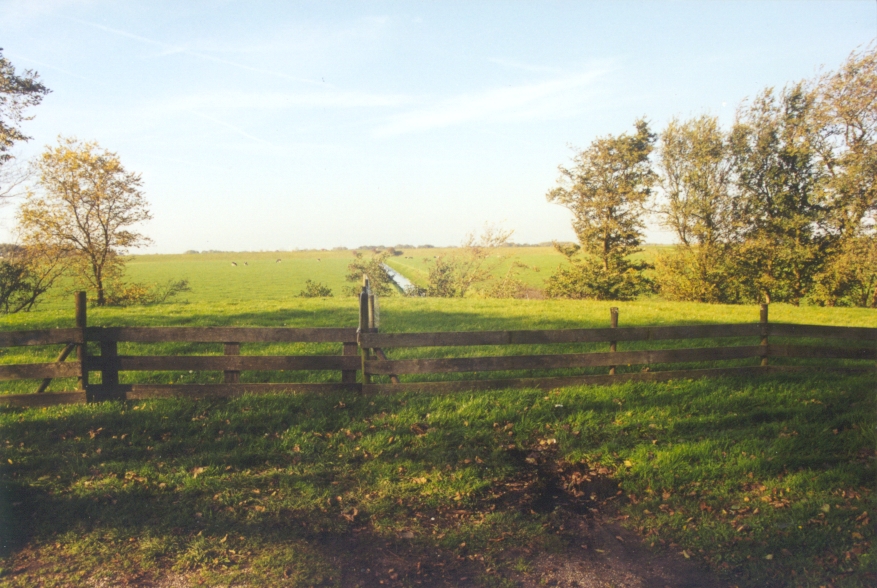 |
| View from the top of the mound to the surroundings of the village of Eenigenburg | 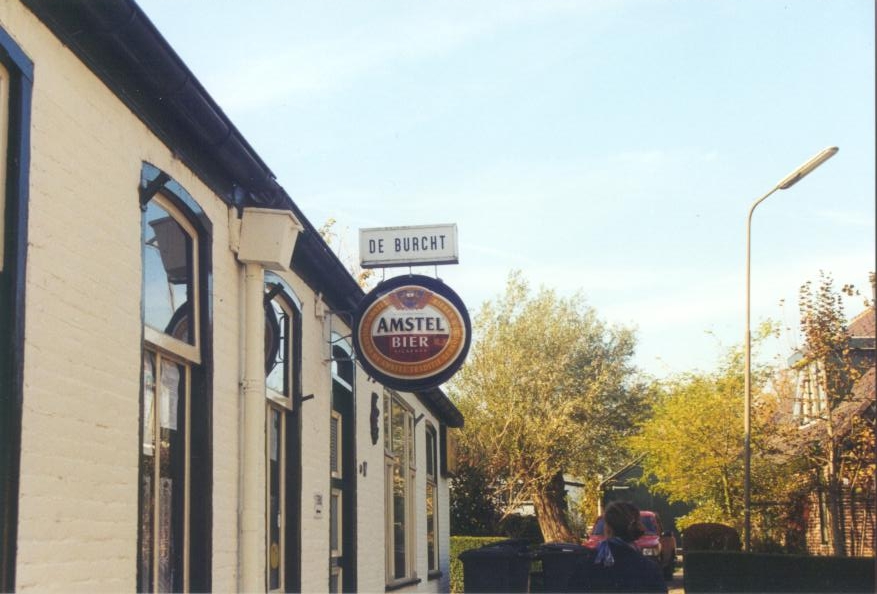 | At the foot of the mound you wil find the cafe with an appropriate name! The Dutch word 'burcht' can mean castle, fortress or stronghold.
(Photos: Ben Dijkhuis). |
Literature cited:
(Lit. 5, J.W. Groesbeek)
(Lit. 19, P. Noordeloos)
(Lit. 34, J. de Vries)
(Lit. 35, G. van Berkel, K. Samplonius)
(Lit. 48, J.G.N. Renaud)
|
